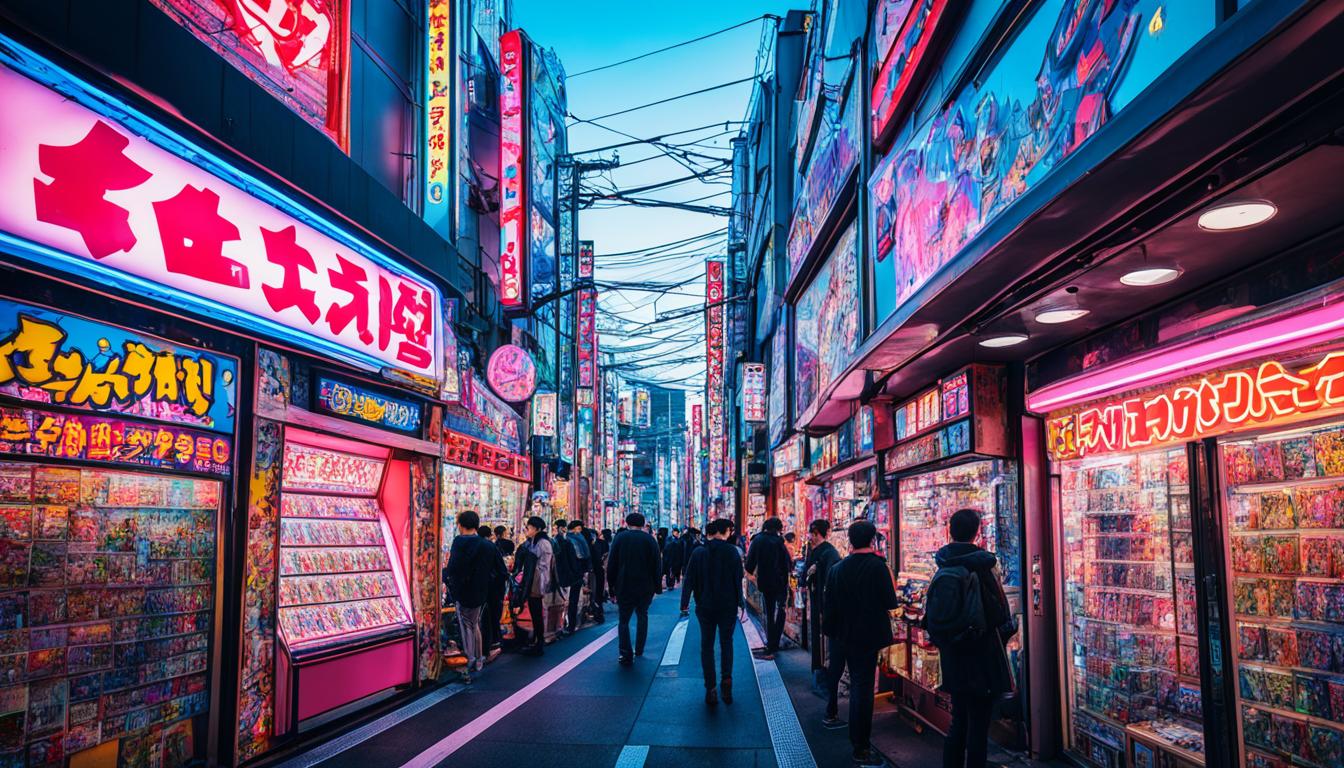Japan is the
third largest video game market
in the world, behind China and the United States. It had about
67.6 million players
in 2018. This shows how important Japan is for video game creation and ideas.
Japanese video games have a huge impact on the gaming world. Companies like Nintendo, Sega, and Square Enix are well-known. Games like Super Mario, Pokémon, and Final Fantasy are loved around the globe.
What makes Japanese games stand out? They do things differently, adding special sounds, looks, and stories. Plus, they draw from their rich history and culture. This makes their games unique and appealing.
These games don’t stop at video screens. Many become anime, TV shows, and even music projects. This mix with other art forms boosts their influence. It shows how far the love for Japanese video games goes.
This article is your guide to Japanese video games’ rich world. We’ll look at their past, key people, favorite game types, and cultural effects. Let’s explore together the amazing world of Japanese video games.
Key Takeaways:
- Japan is the third largest video game market globally, with about 67.6 million players.
- Japanese video games have heavily influenced the gaming world and culture worldwide.
- They are known for their unique style, from how they look and sound to their stories and originality.
- They have also impacted and worked with different entertainment types, like anime and music.
The Rise of Japanese Gaming Giants
Sega and Nintendo are top players in the Japanese video game scene. They’re known for shaping the game world in Japan and globally. We’ll delve into their game-changing contributions and impacts on the industry.
Sega: Revolutionizing Arcades and Beyond
Founded in 1960, Sega made a splash with its advanced arcade machines that hooked gamers everywhere. Hits like “Space Invaders” and “Out Run” were born, fitting into the era’s love for arcades. Their fame grew when they began competing with Nintendo, launching the Sega Genesis/Mega Drive to rival the SNES.
Nintendo: Bringing Gaming to Every Home
Sega may have led the arcade front, but Nintendo transformed home gaming. They released the Famicom in 1983, which later became the NES, making favorites including “Super Mario Bros.” and “The Legend of Zelda.” Nintendo’s commitment to excellence and innovation, led by Shigeru Miyamoto, pushed them to be gaming’s leading light.
Sony PlayStation: Redefining Gaming with 3D Graphics
Sony joined the game in the mid-1990s, changing the scene with the PlayStation’s 3D focus. Launched in 1994, it was a hit, selling 100 million. The success continued with the PS4, which became the top-selling console of its time. This boosted Sony’s gaming status considerably.
Shigeru Miyamoto: The Creative Force Behind Nintendo’s Success
Shigeru Miyamoto is a key figure in the Japanese gaming world, credited as the father of modern video games. His work on series like “Super Mario,” “The Legend of Zelda,” and “Donkey Kong” has earned global praise. Thanks to his inventive ideas and careful eye for detail, the industry has been heavily influenced.
Japanese arcade culture and signature video game series are widely loved and respected worldwide. Titles like “Super Mario,” “Pokémon,” and “The Legend of Zelda” have deeply connected with players and emerged as cultural icons. These games are loved across the globe, highlighting the immense impact of Japanese gaming leaders.
Gaming Platforms in Japan
Japan is a hub for diverse gaming platforms, attracting a broad audience. It includes arcade machines, mobile phones, and gacha games. This variety shows how Japanese gaming culture meets the interests of many people.
Arcade Machines
In Japan, arcade machines play a big part in cultural life. There are many gaming centers in cities, such as Tokyo’s Akihabara Electric Town. These places are vibrant and full of various games to enjoy.
Japanese companies have led in developing arcade games for years. They bring new ideas and technologies to the gaming industry. Classics like Taito’s Speed Race and Gun Fight are examples of their creative work.
Mobile Phones
Mobile phones are now a top choice for gaming in Japan. Both Androids and iPhones are very popular. Their portability makes them convenient for players of all ages.
Game developers have focused on making fun mobile games. These games have become very popular and successful in Japan. Now, mobile games earn more money than console games, showing their standing among gamers.
Gacha Games
Gacha games stand out as a unique gaming option in Japan. They are named after the toy vending machines “gacha.” Players use in-game currency to get random items or characters.
iDOLM@STER, Granblue Fantasy, and Fate/Grand Order are some of the well-known gacha games. They are exciting because players can get rare and powerful items through luck. This system keeps players interested and coming back for more.
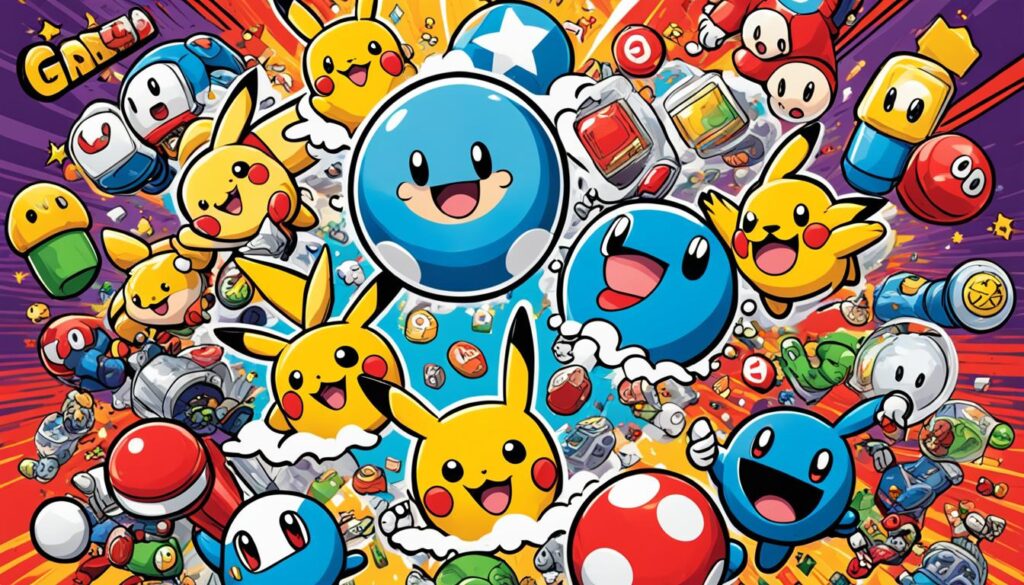
Japan’s gaming scene is rich and varied, offering something for every gamer. From the social atmosphere in arcades to the mobile gaming on the move and the excitement of gacha games, Japan remains a key player in the world of gaming.
Japanese Role-Playing Games (JRPGs)
Japanese role-playing games (JRPGs) have become very popular in the West over the last 15 years. They are more accessible now, thanks to better translations and game ports. This allows gamers worldwide to enjoy the unique JRPG experience.
JRPGs are known for their art style, which is similar to Japanese animation and comics. This helps create beautiful worlds and characters that stand out. Many gamers love these elements in JRPGs.
These games often have a party system. This means you control a group of characters, each with their own skills and personality. It makes the gameplay richer, with more strategies to use.
Consoles from Japanese companies, such as Nintendo and Sony, offer many JRPGs. They have a large selection of games for fans to choose from. This has made these consoles strong contenders in the gaming world.
Recently, several JRPGs have become very popular. For example, Xenoblade Chronicles 3 and Genshin Impact have been big hits. They offer long, epic adventures and detailed open worlds.
The Dragon Quest series, with its famous character designs, is still loved today. Games like Pokémon Brilliant Diamond have also been updated. They offer fans a chance to relive old memories.
Good JRPGs like NieR: Automata are highly regarded for their stories and worlds. They are seen as among the best in the gaming world. These games show what JRPGs are capable of.
As an author, I have played many JRPGs. Demon’s Souls was special to me because of its Western touch. It was the only JRPG I finished in 2011.
Final Fantasy has been a big part of my gaming experience. I’ve played many titles in the series, each offering a different story. They have added a lot to my love for the genre.
Playing different JRPGs has shown me unique gameplay. For instance, “Blue Dragon” was fun for achievement hunting. “Enchanted Arms” had an interesting grid battle system.
Some games introduce standout elements. “Baten Kaitos: Eternal Wings and the Lost Ocean” was loved for its card fighting. “Eternal Sonata” had an intriguing plot set around a pianist.
Games like “Atelier Iris: Eternal Mana” are known for detailed gameplay. The alchemy system in it adds a lot. “Breath of Fire III” rewarded players who put in the time.
I have played JRPGs on many platforms, including handhelds and consoles. This variety deepened my understanding of JRPGs. It showed me their diverse stories and features.
In conclusion, JRPGs offer a unique experience with their art, stories, and gameplay. They continue to influence the gaming world, giving players lasting memories.
Visual Novels in Japanese Gaming
Visual novels are video games from Japan that mix storytelling with choices you make. They have become a hit around the world. Within this genre are dating sims, bishōjo games, and otome games. These kinds appeal to different groups of people.
Visual novels put a big focus on the story and letting the player choose. The story often has many branches, not just a straight line. What you decide changes the story and leads to various endings. This makes the game more fun and interesting to play.
Many of these novels are about love and dating, making them loved by fans. Dating sims are about talking to characters and getting to know them, often leading to romance. Bishōjo games are for guys and focus on dating beautiful girls. Otome games, on the other hand, are for girls who like games with handsome guys.
Playing these games can really get you attached to the characters and their stories. Every choice you make affects where the story goes. This is why people find them so engaging.
Visual novels are also known for their great character artwork and sometimes even voices. Some stories have become so popular they got adapted into anime. This has helped them attract even more fans.
While these games are big in Japan, they’re not as popular elsewhere. But, because of tools like NScripter and Ren’Py, more people worldwide are making their own novel games. This is getting them noticed outside Japan too.

The Popularity of Gacha Games in Japan
Gacha games are a big hit in the mobile gaming world, especially in Japan. They are named after the vending machines in Japan called “gacha.” These games use a special lottery system that keeps the players coming back. They are free to play, which means lots of people can enjoy them.
Gacha mechanics have become an integral part of Japanese mobile game culture and have gained popularity in other countries, including China, Korea, Europe, and the United States.
In these games, players use in-game money to win random characters or items. This makes the game more exciting. Players try their best to get rare and valuable things.
Monetization is a key aspect of gacha games, with players incentivized to spend real-world money in their pursuit of rare characters and items. However, this aspect has also led to criticism, as gacha games are often compared to gambling due to the allure of potentially valuable rewards.
Some gacha games have a system where players are guaranteed rare items if they try enough times but don’t win. This helps players feel like their efforts are worth it. It shows that the game developers value their dedication.
Gacha games have complicated in-game currencies. There are special and regular types. It’s hard to know the real value of these different types. Players can earn these by doing daily tasks, getting rewards, or from special offers.
In Japan, gacha games often feature limited-time offerings known as banners, which provide exclusive characters or items for a set period. This creates a sense of urgency and encourages players to engage with the game regularly.
Stamina is also vital in gacha games, needed for many game actions. Players can buy more stamina to keep playing without a break.
There are many kinds of gacha games with different ways to play. Some include Complete Gacha, Box Gacha, Redraw Gacha, Consecutive Gacha, and Step-up Gacha. Each one adds a new element to the game’s lottery system, making it more fun and varied for players.
[blocktable]
Gacha games in Japan and their impact
| Game | Release Year | Notable Features |
|---|---|---|
| Dragon Collection | 2010 | Became one of Konami’s top-grossing games |
| Final Fantasy: Brave Exvius | N/A | One of the most popular gacha games in Japan |
| All top-10 highest grossing games in Japan | N/A | Utilize the gacha monetization model |
Gacha games have changed the gaming world, making a lot of money for developers. These games are fun, but some people are worried about how they work. Yet, they are loved in Japan and other places, shaping how we play games on our phones.
The History of Japanese Video Games
Japanese video games have a rich history over many decades. They’ve hit big milestones that changed the game world. From early arcade games to today’s high-tech consoles, Japan has always been a key player.
In 1966, the first big win happened with an arcade game called Periscope. It let players imagine sinking ships and was hugely popular. This set the stage for the future of arcade fun.
The 1980s saw a big battle between Nintendo and SEGA. Nintendo’s Game Boy stole hearts in 1989, while SEGA impressed with the SEGA Mega Drive/Genesis in 1988.
Sony joined in 1994 with the PlayStation, pushing boundaries with 3D and deep games. It quickly became a favorite, helping Sony lead in gaming.
Game designers like Hideo Kojima have also made a big impact. His Metal Gear Solid series stands out for its deep stories and gameplay.
Metal Gear Solid for the PlayStation in 1998 was a huge moment. It wowed players with its story and game style, making it legendary.
The fighting game scene owes a lot to Japan. Street Fighter II by Capcom and Tekken by Namco set new bars in 1990s. They added moves and 3D graphics that’s become the standard.
JRPGs have a special place too, thanks to Final Fantasy by Square in 1987. These games tell grand stories with fantastic worlds and characters. They’re still beloved today.
Japanese video games bring creativity and culture to players around the world. They’re known for their sound, look, stories, and history. Japanese games are a unique and treasured part of the game world.
| Year | Event |
|---|---|
| 1966 | Release of Periscope, an arcade game simulating sinking ships |
| 1983 | Release of the Famicom (NES) with the beginning of Nintendo’s strict control over game releases |
| 1988 | Release of the SEGA Mega Drive (Genesis) with 16-bit technology |
| 1989 | Nintendo dominates the handheld console market with the release of the Game Boy |
| 1991 | Capcom’s Street Fighter II revolutionizes the fighting game genre |
| 1994 | Sony introduces the PlayStation, becoming a major player in the video game market |
| 1995 | Namco’s Tekken sets new standards for 3D graphics in fighting games |
| 1998 | Release of Metal Gear Solid for the PlayStation, receiving critical acclaim globally |
The Impact of Japan on Video Game Culture
Japan has changed video game culture in a big way. It’s thanks to creative game makers and famous designers. Shigeru Miyamoto and Hideo Kojima are two key people in this field.
Shigeru Miyamoto: Shaping Modern Gaming
Shigeru Miyamoto is a top figure in video game history. His innovations have greatly influenced modern gaming. He’s most famous for creating games like Super Mario and The Legend of Zelda.
Super Mario brought new gameplay that has become a standard in video games. Its fun characters, levels, and worlds are well-loved. Miyamoto made his games easy to pick up for everyone.
The Legend of Zelda games offer vast worlds for players to explore. This was something new, giving players freedom in their adventures. Miyamoto’s games also mix storytelling with fun gameplay.
Hideo Kojima: Revolutionizing Storytelling and Gameplay
Hideo Kojima is another game designer who’s made a big impact. His work includes games like Snatcher and Metal Gear Solid. Kojima is known for his unique stories and game mechanics.
Metal Gear Solid revolutionized how games tell stories. It feels like playing a movie with its deep stories and complex characters. The games make players think.
Kojima’s games also introduce unique gameplay. For example, Metal Gear Solid focuses on sneaking and has detailed environments. This made him popular with fans all over the world.
Influential Fighting Games: Street Fighter and Tekken
Japanese developers have also led the way in fighting games. Titles such as Street Fighter and Tekken, from Capcom and Namco, have made a big impact.
Street Fighter, since 1987, has been about one-on-one fighting with unique characters. It is a big deal in competitive gaming. There are global tournaments for it every year.
Tekken, since 1994, has been a top 3D fighting game. It features deep fighting systems and memorable characters. It’s highly regarded in the fighting game scene.
Street Fighter and Tekken are still successful. They keep influencing new fighting games. Their success shows the ongoing power of Japanese game making.
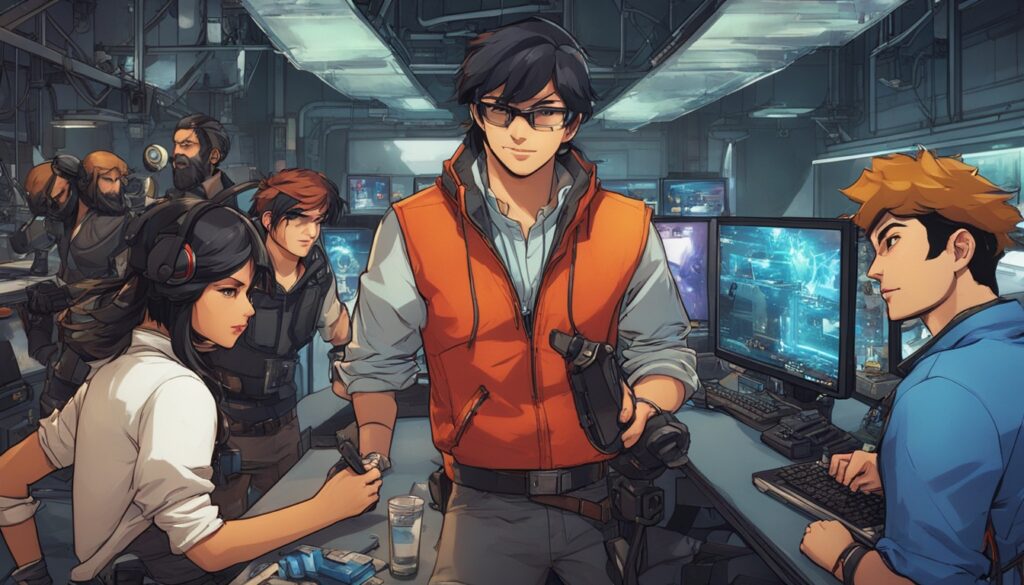
In the end, Japan’s efforts in game development have greatly influenced video games. Thanks to designers like Shigeru Miyamoto and Hideo Kojima, we have advanced in storytelling and game creation. These contributions continue to motivate the industry and players worldwide.
The Influence of Japanese RPGs
Japanese role-playing games (JRPGs) are famous in the gaming world, especially through series like Final Fantasy and Dragon Quest. They stand out with unique looks and deep stories. JRPGs have won over fans around the globe.
The Final Fantasy series by Square Enix has sold over 150 million copies. These games are loved for their stunning visuals, unforgettable characters, and detailed stories. They’ve really raised the bar for storytelling in video games.
Another hit, Dragon Quest, has been a favorite in Japan for more than 30 years. Known for its colorful style and classic RPG elements, it offers a nostalgic journey. Players enjoy its old-school charm.
One key part of JRPGs is their special look, often inspired by manga and anime. This style makes the games feel alive, with vivid worlds and unique characters. It helps immerse players in the game’s universe.
But what really makes JRPGs shine is their stories. They’re known for epic tales that delve into deep themes like friendship and the battle of good versus evil. The focus on characters and their relationships makes the game more personal, leaving a strong impact on players.
JRPGs offer players a chance to embark on epic adventures, immersing themselves in fantastical worlds filled with memorable characters, intricate storylines, and awe-inspiring visuals.
Thanks to Final Fantasy and Dragon Quest, many other incredible JRPGs exist. They’ve inspired game makers all over the world. From well-known titles to hidden gems, these games have a lasting impact, captivating players of all ages.
The Legacy of Arcade Culture in Japan
Arcade culture in Japan has had a huge impact on gaming worldwide. It has influenced both how we play games and what we expect from them. Games like Karate Champ, Street Fighter, and Tekken are from Japan. They changed the gaming industry, especially in the fighting game category.
These games are more than just fun. They are iconic and have inspired many game developers. For example, Street Fighter introduced deep gameplay and strategic combat. It set the standard for Japanese arcade games.
“Arcade culture in Japan has been instrumental in shaping the gaming industry. Games like Karate Champ, Street Fighter, and Tekken paved the way for the one-on-one combat genre, captivating players with their intense gameplay and memorable characters.”
Arcades in Japan still attract players of all kinds. They draw in everyone from workers to students. Japan’s arcade scene is lively and diverse. It brings many people together to enjoy gaming.
Arcade culture is deeply rooted in Japan. Players don’t just go to arcades to play. They go for a unique experience they can’t get at home. One of the best parts is the chance to compete and interact face-to-face with others.
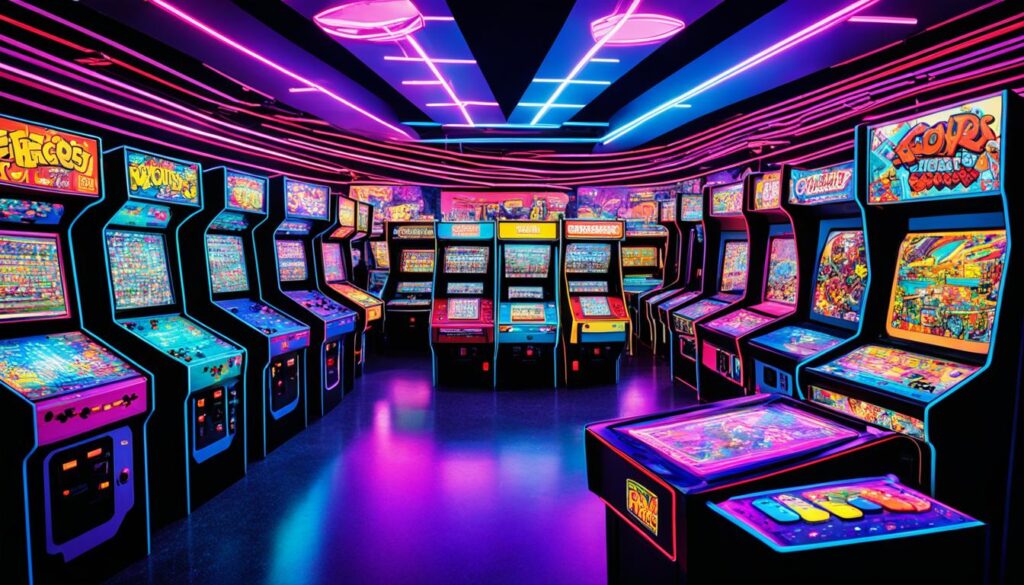
| Arcade Games | Arcade Chains |
|---|---|
| Purikura | Sega (GiGO) |
| UFO Catchers | Taito |
| Rhythm Games | Round1 |
| Traditional Arcade Games | |
| Card Games |
Japanese arcades are known for their wide game selection. They have everything from rhythm games like Maimai to traditional and card games. Arcade card games add a collectible element. They are a hit with young players.
Arcades in Japan have something for everyone. You can test your skills in games like Street Fighter. Or, try to win prizes in crane games. The arcade culture there is always evolving. It offers new and exciting gaming experiences.
The Evolution of Japanese RPGs
Japanese role-playing games (JRPGs) have changed a lot over the years. Square Enix, a famous game company, has been a key player in this change. The Final Fantasy series, made by Square Enix, is one of the big names. It’s loved all over for its amazing look and deep stories.
Dragon Quest, another series by Square Enix, is also very important. It focuses on classic JRPG features like turn-based fights and big, detailed worlds. Both Final Fantasy and Dragon Quest have shaped the games’ looks and stories. They use art and stories that are like anime and manga.
But the world of JRPGs is even bigger than these two well-known series. It now includes many types of games, like strategy RPGs and games where you explore dungeons. Each kind of game has its own special way of playing and telling stories. This variety makes the genre even more interesting.
Many people, from fans to experts, have helped JRPGs become what they are today. Their dedication and knowledge have pushed the games to new heights. They’ve played a big part in making these games loved all over the world.
Since 1982, over 600 JRPGs have been made. This long history shows how the genre has kept changing and staying popular. Whether it’s new ways to play or great stories, JRPGs keep drawing in players. They have left a big mark on the world of gaming.
| Book Details | Statistics |
|---|---|
| Regular price | £34.99 GBP |
| Page count | 652 pages |
| Book dimensions | 254mm × 203mm |
| Weight | 2.5kg |
| Games covered | Over 600 JRPGs from 1982 to 2020 |
| Contributors | Wide selection of fans and journalists |
| Binding | Sewn binding for durability |
| Visuals | High-quality lithographic print showcasing artwork |
| Division | Each divider features a specially created ‘overworld map’ |
| Cover | Special artwork with metallic silver foil details |
| Contributors | Collaboration with author Kurt Kalata |
| Sub-genres | Covers a wide range, including strategy RPGs, rogue-likes, and first-person dungeon crawlers |
| Content | Over 370,000 words of reviews and articles |
| Features | Free PDF for viewing on the go |
| Art | Cover features specially created artwork by Stephanie Sybydlo |
Japanese Difficulty in Video Games
Japanese video game makers are leading the way in tough gameplay. They made Demon Souls, a big hit in 2009. This game was known for being very hard and not forgiving.
The popularity of Demon Souls led to more hard games. Now, gamers everywhere want to face tough challenges. They enjoy the feeling of achieving something very hard.
“Playing Demon Souls felt like a breath of fresh air for gamers looking for a real challenge. It required strategy, patience, and perseverance to overcome its tough enemies and intricate level design.” – GameReview.com
But, the difficulty in Japanese games is not just about fighting hard monsters. Even easy modes in these games are tough. This shows how game design varies across cultures.
“Japanese games often present a unique challenge, not just because of their difficulty, but because of the way they test your skills, reflexes, and problem-solving abilities. It’s a different kind of satisfaction that you don’t often find in Western games.” – GamingEnthusiast.com
Japanese games, from fighting games to RPGs, can be very difficult. For example, Ninja Gaiden 3 RE has very smart opponents. They feel like they’re cheating, making the game harder.
There’s also a cultural view on game difficulty in Japan. They see tough but fair games as the same as games that are just hard because they’re not well made. This could be why some Japanese games seem to have unfair challenges.
Many people feel Japanese games don’t reward gamers enough. They might not get much after working hard in the game. Western games, on the other hand, often give good rewards. This can sometimes upset players.
It’s important to know that not all Japanese games are like this. And, not all Western games are different. Game makers in both places are always trying new things with game difficulty.
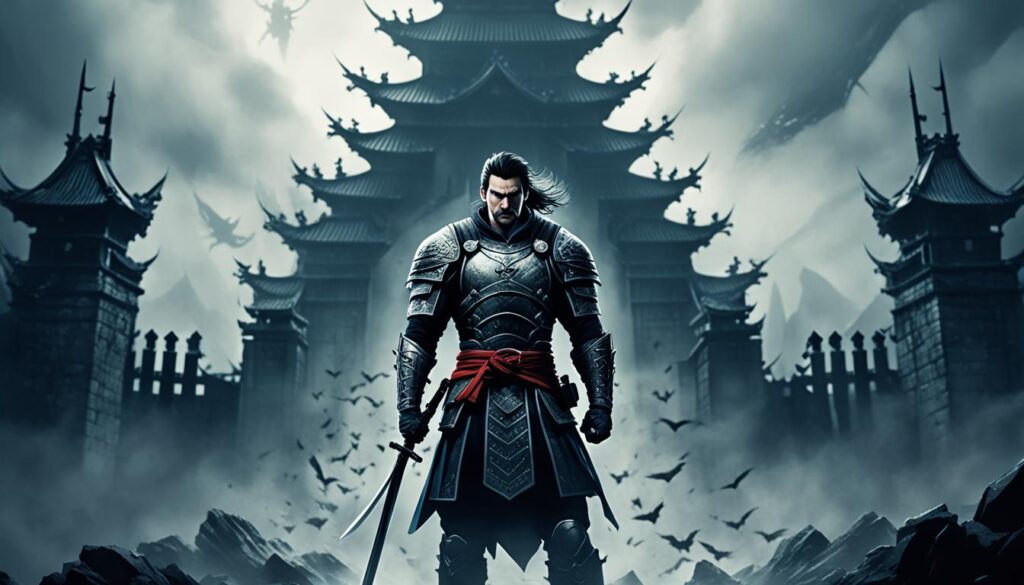
To sum up, Japanese games have had a big impact on game difficulty. Games like Demon Souls showed the world how exciting tough games can be. They make games that push your skills and reward your hard work. These games make the gaming world more interesting, offering challenges that are worth overcoming.
Exploring Japan Through Video Games
Video games let you dive into Japan’s amazing culture. You can explore today’s Tokyo or go back in time to ancient Japan.
They show off Japan’s different places and famous sites. With beautiful images, they bring Japan’s beauty and history to life.
Ōkami is a game that takes you to the land of Nippon. You’ll see grassy hills, pretty coastlines, and even an undersea palace. The game looks like a Japanese painting, making the world feel alive.
While playing, you learn about Japan’s culture and history. You’ll see shrines, Japanese writing, and more. This makes the game very real and interesting.
The Persona series lets you experience Japan in a unique way. You play as characters who can summon powerful beings.
As you use these special powers, you learn and grow. This reflects a common Japanese theme of self-discovery.
Exploring Real-World Gaming Destinations
The gaming world has also shaped real Japan. It’s famous for its many arcades, with thousands of games.
One such place is Sunshine City in Ikebukuro, where you can find the biggest Pokémon Center in Japan. It’s filled with Pokémon merchandise. Fans love it for the Pokémon items they can buy.
Sega Towers in Akihabara is another cool spot. It’s famous for arcade games and a fun atmosphere. Akihabara is known for its love of gaming.
To see where gaming began, visit the Huis Ten Bosch Game Museum in Nagasaki. It has old and new gaming consoles and games. For gamers, it’s a dream come true.
A Glimpse into the Future
Japan is building more places to celebrate games and gaming culture.
In Tokyo’s Ginza district, the Ginza Sony Park brings gaming and art together. It’s a unique place to explore.
In Kyoto in 2024, the Nintendo Museum will open. It will showcase Nintendo’s history and games, giving fans a close look at their favorites.
Finally, there’s the Square Enix Café in Akihabara and Shinjuku. It has food inspired by games, like Sea Salt Ice Cream from Kingdom Hearts. Game lovers should visit for sure.
A Journey through Immersive Worlds
Through video games, players virtually explore Japan’s rich culture and history. You can visit busy cities and calm countryside. Every step offers a look at Japan’s unique beauty.
These virtual worlds are like tours, letting players see Japan in new ways. They learn about the country through fun adventures.
| Game | Description |
|---|---|
| Ōkami | Embark on a visually stunning journey through lush fields, picturesque coastlines, snowy forests, and an enchanting undersea palace as you uncover the secrets of ancient Japan. |
| Persona 4: Golden | Step into the shoes of a high school student in rural Japan and navigate the challenges of daily life while uncovering a thrilling mystery in this beloved JRPG. |
| Persona 5 | Immerse yourself in the vibrant streets of modern-day Tokyo as a high school student by day and a phantom thief by night, battling supernatural forces and uncovering corruption. |
The Cultural Significance of Japanese Video Games
Japanese video games are more than just fun. They show Japan’s culture and society, captivating people worldwide. They often get ideas from anime and manga, creating visually stunning and rich games.
Japanese games stand out with their unique looks. They have colorful worlds and detailed characters. This attention to detail makes each game a beautiful adventure.
But it’s not just the looks that make these games special. It’s also the emotional stories and characters. Players really connect with the game worlds and the deep messages they share.
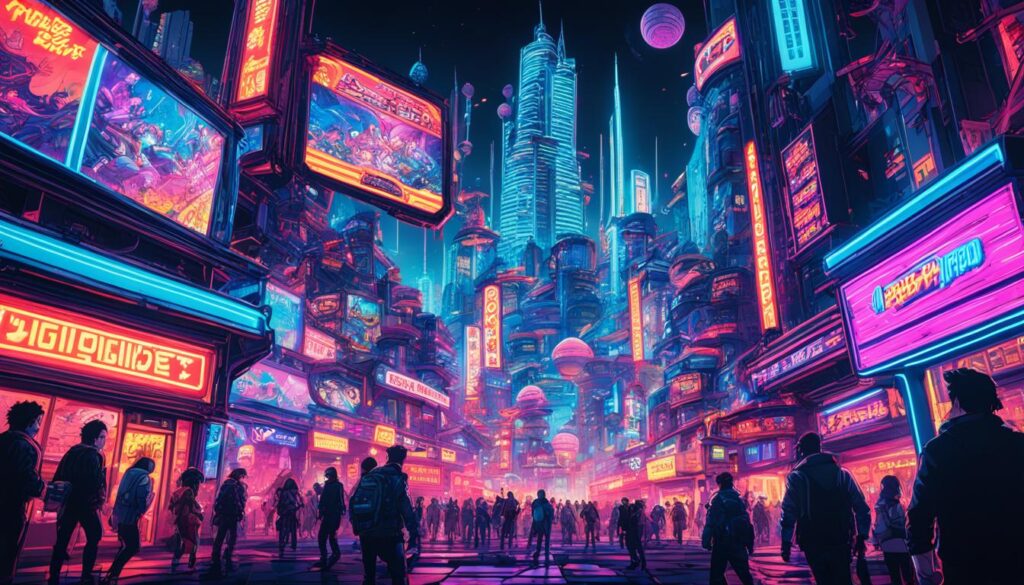
Japanese games have influenced more than just the gaming world. They’ve inspired anime, manga, and movies too. The creativity in these games has sparked new ideas in other forms of entertainment.
Japan has been a key player in video game history since the 1950s. It’s been at the forefront of tech and game design. Japanese developers keep pushing the envelope, leading the way in gaming innovation.
Japanese games truly reflect Japan’s rich culture. They show the country’s strong focus on craft, originality, and history. These games share Japan’s beauty with players all around the globe.
Conclusion
Japanese video games have hugely influenced the gaming world, creating a strong legacy. Since the Magnavox Odyssey in 1975, the Japanese have led with creativity. This was seen clearly with the Nintendo Entertainment System’s launch in 1983.
In 1985, Shigeru Miyamoto unveiled Super Mario Bros., marking a big step for Japan in gaming. Games like Final Fantasy and Dragon Quest have since thrilled fans globally. They’ve sold millions and set trends in the RPG genre for years.
In fighting games, titles like Street Fighter and Tekken have become big hits, changing competitive gaming. The survival horror series, Resident Evil, has also played a major role by selling over 100 million copies worldwide.
Japanese games are more than fun; they’ve influenced how we play and enjoy games. They’ve inspired new game creators too. Their influence continues today, making gamers love their unique stories, engaging gameplays, and immersive experiences.
FAQ
What is the status of the video game industry in Japan?
Japan is very big in video gaming. It has major companies like Nintendo, Sega, and Bandai Namco. Currently, it ranks third globally for video game sales.
Who are the biggest players in the Japanese video game industry?
Sega and Nintendo are major players in Japan. Sega changed arcades, and Nintendo introduced consoles into homes.
Which video game consoles made significant contributions to the Japanese market?
The Famicom by Nintendo and PlayStation by Sony did a lot for Japan. They made 3D gaming popular in Japan.
What are some iconic video game franchises from Japan?
Games like Super Mario, Pokemon, and Zelda are loved worldwide. They’re from Japan and are very popular.
What are the gaming platforms in Japan?
In Japan, people enjoy games on arcade machines and mobiles. Gacha games are also quite popular.
What are gacha games?
Gacha games are about chance. Players spend in-game or real money to get random items or characters.
What are Japanese role-playing games (JRPGs)?
JRPGs are unique. They have stories inspired by anime and manga, turn-based fights, and well-developed characters.
What are visual novels?
Visual novels are like interactive books. Players make choices that affect the story. Some are about romance.
What is the history of Japanese video games?
Japanese games started with Periscope in 1966. A big moment was the Nintendo vs. SEGA battle in the 80s. Then, Sony joined with the PlayStation.
How has Japan influenced video game culture?
Japan is key in game culture. Innovators like Shigeru Miyamoto and a rich story in Metal Gear have influenced games a lot.
What is the influence of Japanese RPGs?
Japanese RPGs have changed the game world. Games like Final Fantasy and Dragon Quest are known for unique looks, deep story, and characters.
What is the legacy of arcade culture in Japan?
Karate Champ and other arcade games laid the fighting genre base. This impact is still seen in today’s games.
How have Japanese RPGs evolved?
Japanese RPGs, thanks to companies like Square Enix, have advanced. Final Fantasy is a big leader, changing RPGs with its fresh look and story.
How have Japanese video games set trends in difficulty?
Demon Souls marked a push for harder games in 2009. This led to more games focusing on challenging players.
Can video games provide a virtual tour of Japan?
Yes, games can take you through modern or old Japan. They offer a look at Japan’s culture and places.
What is the cultural significance of Japanese video games?
Japanese games reflect the country’s culture and life. They often look to anime and manga for style.
What is the overall impact of Japanese video games on the industry?
Japanese games have greatly impacted the industry. Their developers, iconic games, and unique styles continue to inspire the world of gaming.
Source Links
- https://en.wikipedia.org/wiki/Video_games_in_Japan
- https://www.kinephanos.ca/2015/history-of-japanese-video-games/
- https://www.japannakama.co.uk/the-cultural-impact-of-japanese-video-games/
- https://gam3s.gg/news/japan-gaming-renaissance-via-web3/
- https://gamestudies.org/1302/articles/picard
- https://www.cnn.com/2017/11/12/asia/future-japan-videogame-landmarks/index.html
- https://allcorrectgames.com/insights/the-gaming-market-in-japan/
- https://www.digitalmarketingforasia.com/what-you-should-know-about-the-japanese-game-industry/
- https://www.forbes.com/sites/technology/article/best-jrpg-games/
- https://www.giantbomb.com/profile/mento/lists/japanese-role-playing-games-i-ve-played-a-few/57189/
- https://en.wikipedia.org/wiki/visual_novel
- https://community.wanikani.com/t/visual-novelsgames-in-japanese-available-on-steam/39477
- https://en.wikipedia.org/wiki/Gacha_game
- https://www.businessofapps.com/insights/a-comparison-of-the-mobile-app-gaming-markets-in-japan-and-the-united-states/
- https://medium.com/@john_23522/the-history-of-gacha-in-video-games-2f5640a3160d
- https://row.oneblockdown.it/blogs/archive/sabukaru-japan-video-games-history-legacy-nintendo-archive-editorial
- https://medium.com/@shotayamashita223/influence-of-japanese-culture-on-game-design-exploring-the-impact-on-the-gaming-industry-f2cb8075d42f
- https://en.wikipedia.org/wiki/History_of_Eastern_role-playing_video_games
- https://www.tsunagujapan.com/japanese-arcades/
- https://www.bitmapbooks.com/products/a-guide-to-japanese-role-playing-games
- https://gamefaqs.gamespot.com/boards/204-classic-gaming/80375555
- https://gamefaqs.gamespot.com/boards/927750-playstation-3/66988511
- https://japaneserpg.wordpress.com/2014/12/05/games-as-study-language-difficulty-list/
- https://blog.japanwondertravel.com/8-places-to-explore-japans-gaming-culture-12512
- https://digitalcommons.ursinus.edu/cgi/viewcontent.cgi?article=1005&context=eastasia_hon
